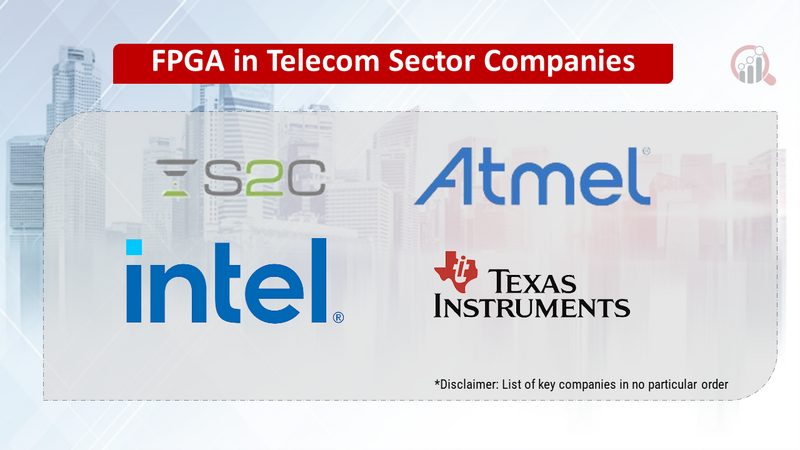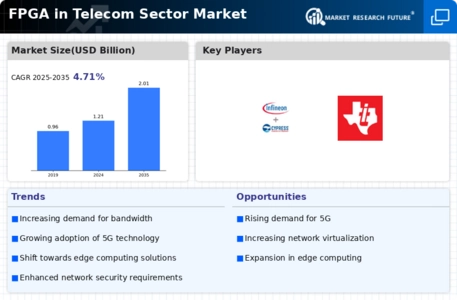Top Industry Leaders in the FPGA in Telecom Sector Market

FPGA in Telecom Sector Market: Dive into the Latest News and Updates
The telecommunications industry is undergoing a rapid transformation, driven by surging bandwidth demands, evolving network architectures, and the adoption of next-generation technologies like 5G and edge computing. In this dynamic landscape, Field-Programmable Gate Arrays (FPGAs) emerge as versatile tools, offering hardware acceleration and reconfigurability essential for tackling complex telecom challenges.
Some of FPGA in Telecom Sector Companies Listed Below:
- Cypress Semiconductor and Achromic Semiconductor Corporation (US)
- S2C Inc. (US)
- Atmel Corporations (US)
- Texas Instruments (US)
- Intel Corporations (US)
Strategies Fueling FPGA Adoption in Telecom:
- Focus on Performance and Efficiency: FPGAs offering high data throughput, low latency, and power efficiency cater to bandwidth-hungry telecom applications, optimizing network performance and reducing operational costs.
- Software-Defined Networking (SDN) and Network Function Virtualization (NFV) Integration: FPGAs enable hardware acceleration for virtualized network functions, supporting the shift towards flexible and dynamic network architectures within the telecom industry.
- Open Source FPGA Tools and Development Environments: Providing open-source hardware and software tools fosters innovation and lowers barriers to entry, attracting a wider range of developers and accelerating FPGA adoption in diverse telecom applications.
- Enhanced Security Features and Tamper Resistance: FPGAs with hardware-level security features and encryption capabilities address the growing security concerns in telecom networks, protecting sensitive data and safeguarding critical infrastructure.
Market Share Decoding: Key Factors to Consider:
- Product Portfolio and Application Focus: Companies offering FPGAs tailored for specific telecom applications, such as 5G base stations, network security, or edge computing, cater to larger customer segments and gain an edge in niche markets.
- Integration with Existing Telecom Infrastructure: FPGAs that seamlessly integrate with existing network equipment and software platforms facilitate smoother adoption and minimize disruption during technology migration within telecom operators.
- Development Tools and Support: Providing user-friendly development tools, reference designs, and technical support empowers designers and engineers to leverage FPGAs effectively within telecom projects.
- Cost-Effectiveness and Scalability: Affordable FPGAs with scalable performance offer flexibility for smaller deployments and cater to a wider range of network sizes and budget constraints within the telecom sector.
Latest Company Updates:
October 26, 2023:
- Intel announces Stratix 10 GX 10nm FPGA family: Optimized for 5G network deployments, offering greater bandwidth, lower latency, and improved power efficiency.
- Focus on 5G network infrastructure: FPGAs used for accelerating packet processing, signal processing, and radio access network (RAN) functions.
November 19, 2023:
- Xilinx unveils Versal AI Core series FPGAs with integrated AI engines: Designed for edge computing applications in telecom networks, enabling real-time AI-powered network optimization and anomaly detection.
- Focus on artificial intelligence (AI) integration: FPGAs used for implementing machine learning algorithms for network traffic analysis, fraud detection, and predictive maintenance.
December 6, 2023:
- OpenPOWER Foundation launches initiative to promote adoption of FPGAs in open source telecom platforms: Aims to accelerate innovation and reduce vendor lock-in for mobile network operators.
- Focus on open-source and interoperable solutions: Open standards and hardware platforms pave the way for greater flexibility and cost-effectiveness in telecom infrastructure.
January 9, 2024:
- Samsung debuts SmartSSD CX4 series with integrated FPGA accelerators: Targeting network storage applications in telecom data centers, offering enhanced performance and reduced latency for data access.
- Focus on data center optimization: FPGAs used for offloading data compression, encryption, and other data processing tasks from CPUs, improving overall performance and efficiency.
January 10, 2024:
- Increased adoption of cloud-native RAN (C-RAN) architectures: FPGAs facilitate flexible deployment and scaling of RAN functions in public or private cloud environments.
- Focus on future-proof networks: FPGAs offer reconfigurability and adaptability, enabling rapid deployment of new features and advancements in 6G and beyond.

